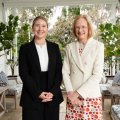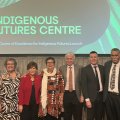Following on news that a coral bleaching incident is rapidly developing on Australia’s Great Barrier Reef, University of Queensland researchers are working with NASA to understand what this event means for the world’s oceans.
UQ Research Fellow Dr Scarla Weeks is implementing satellite monitoring of the larger scale dynamics, including ocean temperature and currents, to understand the oceanographic patterns involved in the bleaching process.
Dr Weeks is collaborating with the NASA/Goddard Space Flight Centre’s Ocean Biology Processing Group (OGBP), which is providing one kilometre resolution MODIS satellite data in near-realtime, and with fellow scientists from the UQ and the Australian Institute for Marine Science.
“This combined expertise is providing key perspectives on what may be a huge change within the world’s largest coral reef ecosystem,” Dr Weeks said.
“Satellite technology has become critical to our efforts to understand the changes going on.
“By studying water temperature and ocean colour, we are gaining insights into the changing dynamics and biological response, and how complex and vast these really are.”
The onset of the new bleaching event has triggered the Australian and US multi-institutional collaborative effort.
“The NASA OBPG has put enormous effort into bringing the benefit of satellite technology to the broadest user community,” Dr Weeks said
“We need to make every effort to use this effectively to better understand and protect our beautiful planet wherever possible”.
Dr Weeks is sponsored by the Pew Institute of Ocean Science (PIOS), a component of the Rosenstiel Institute of Marine and Atmospheric Science, of the University of Miami.
PIOS Director Dr Ellen Pikitch said coral reefs were nearly everyone’s favourite marine ecosystem as well as probably the one most threatened by global warming and other human-associated stresses.
“PIOS is extremely pleased to be part of this collaborative scientific effort, together with NASA and Australian colleagues, to develop greater understanding of the bleaching process and its wider ecosystem effects,” Dr Pikitch said.
Coral bleaching is associated with increased sea surface temperatures and occurs when the symbiosis between corals and tiny algae breaks down. The coral polyps expel the symbiotic, coloured micro-algae that live in their tissues and turn a stark white when they bleach. If conditions last for long enough, corals will die as they did in 1998 and 2002.
Prolonged coral bleaching can lead to coral death and the subsequent loss of coral reef habitats for a very wide variety of marine life.
In addition to the corals themselves, other components of the marine ecosystem appear also to be seriously affected by the increased sea surface temperature causing the current bleaching event.
Scientists from James Cook University (JCU) have found that seabird chicks are receiving extremely low feeding rations, are losing weight and growing numbers of their parents have been observed abandoning their nestlings.
JCU researchers believe this is due to the fact that adult birds had to forage longer to find food to feed the chicks.
“The new satellite monitoring tools will shed light on this changing ocean productivity resulting from the increasing sea surface temperature,” Dr Weeks said.
UQ’s Director of the Centre for Marine Studies Professor Ove Hoegh-Guldberg, who earlier this month announced his concerns over the imminent bleaching event, said the benchmark bleaching threshold at the University’s Heron Island Research Station was exceeded on December 20.
“So far conditions appear very similar to those that led to the 2002 event, which was the worst bleaching event on the Great Barrier Reef on record,” he said.
“Temperatures for the waters of the southern Great Barrier Reef have been extremely warm and now January is turning out to be well above the long-term average temperatures.
“We already have the first inklings of bleaching on the reef slope, while the reef crest corals are looking very pale. I expect we will have very white corals within the next two to three weeks.”
Media: for more information, contact Dr Scarla Weeks +61 (7) 3346 9056 (Australia) s.weeks@uq.edu.au or Andrew Bakun +1 (305) 421 4986 (USA) or Chris Saxby at UQ Communications (telephone 07 3365 2479, email c.saxby@uq.edu.au).




